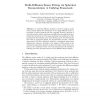Free Online Productivity Tools
i2Speak
i2Symbol
i2OCR
iTex2Img
iWeb2Print
iWeb2Shot
i2Type
iPdf2Split
iPdf2Merge
i2Bopomofo
i2Arabic
i2Style
i2Image
i2PDF
iLatex2Rtf
Sci2ools
98
Voted
MICCAI
2010
Springer
2010
Springer
Multi-Diffusion-Tensor Fitting via Spherical Deconvolution: A Unifying Framework
Abstract. In analyzing diffusion magnetic resonance imaging, multitensor models address the limitations of the single diffusion tensor in situations of partial voluming and fiber crossings. However, selection of a suitable number of fibers and numerical difficulties in model fitting have limited their practical use. This paper addresses both problems by making spherical deconvolution part of the fitting process: We demonstrate that with an appropriate kernel, the deconvolution provides a reliable approximative fit that is efficiently refined by a subsequent descent-type optimization. Moreover, deciding on the number of fibers based on the orientation distribution function produces favorable results when compared to the traditional F-Test. Our work demonstrates the benefits of unifying previously divergent lines of work in diffusion image analysis.
| Added | 14 Feb 2011 |
| Updated | 14 Feb 2011 |
| Type | Journal |
| Year | 2010 |
| Where | MICCAI |
| Authors | Thomas Schultz, Carl-Fredrik Westin, Gordon L. Kindlmann |
Comments (0)

